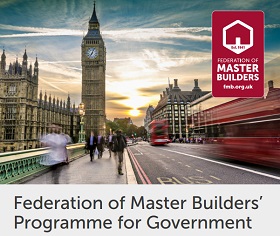FMB - Programme for Government
On 2 May 2017, with the snap general election fast approaching, the Federation of Master Builders (FMB) published a short document entitled 'Programme for Government', providing a five-point plan detailing what commitments they would like to see from the major political parties.
1. Ensure that the construction industry has enough skilled workers:
- Introduce a flexible system of immigration that allows key strategic industries like construction to draw upon adequate levels of skilled labour from the EU and beyond.
- Commit to increasing the quality, duration and thoroughness of apprenticeships and thus improve the image of vocational training so that we can attract more young people into our industry.
2. Increase the supply of new homes:
- The UK government should commit to building at least 200,000 new homes per year in England and encourage the delivery of 25,000 new homes in Scotland; 14,000 in Wales; and 11,000 in Northern Ireland.
- In England, continue to work with the house building industry to successfully implement key recommendations within the 2017 Housing White Paper that are designed to increase house building through SME builders.
3. Improve the quality of new and existing homes:
- Introduce a mandatory warranty requirement for all domestic building works that require Building Regulations approval and structural engineering calculations.
- Commission a review of new homes warranties to establish whether the warranties currently provided are adequate.
4. Make homes more energy efficient:
- Reduce VAT on housing renovation and repair work from 20% to 5% to encourage refurbishment work, including energy efficiency measures.
- Ensure that any government investment in reducing energy bills is targeted primarily at improving the energy efficiency of the UK’s homes.
5. Boost growth among construction SMEs:
- Ensure that the overall regulatory burden on small businesses is reduced as part of the Brexit process.
- Improve public procurement for construction SMEs and ensure local firms win a higher proportion of local authority contracts post-Brexit.
For more information, and to download the document, please see here.
[edit] Related articles on Designing Buildings Wiki
Featured articles and news
RTPI leader to become new CIOB Chief Executive Officer
Dr Victoria Hills MRTPI, FICE to take over after Caroline Gumble’s departure.
Social and affordable housing, a long term plan for delivery
The “Delivering a Decade of Renewal for Social and Affordable Housing” strategy sets out future path.
A change to adoptive architecture
Effects of global weather warming on architectural detailing, material choice and human interaction.
The proposed publicly owned and backed subsidiary of Homes England, to facilitate new homes.
How big is the problem and what can we do to mitigate the effects?
Overheating guidance and tools for building designers
A number of cool guides to help with the heat.
The UK's Modern Industrial Strategy: A 10 year plan
Previous consultation criticism, current key elements and general support with some persisting reservations.
Building Safety Regulator reforms
New roles, new staff and a new fast track service pave the way for a single construction regulator.
Architectural Technologist CPDs and Communications
CIAT CPD… and how you can do it!
Cooling centres and cool spaces
Managing extreme heat in cities by directing the public to places for heat stress relief and water sources.
Winter gardens: A brief history and warm variations
Extending the season with glass in different forms and terms.
Restoring Great Yarmouth's Winter Gardens
Transforming one of the least sustainable constructions imaginable.
Construction Skills Mission Board launch sector drive
Newly formed government and industry collaboration set strategy for recruiting an additional 100,000 construction workers a year.
New Architects Code comes into effect in September 2025
ARB Architects Code of Conduct and Practice available with ongoing consultation regarding guidance.
Welsh Skills Body (Medr) launches ambitious plan
The new skills body brings together funding and regulation of tertiary education and research for the devolved nation.
Paul Gandy FCIOB announced as next CIOB President
Former Tilbury Douglas CEO takes helm.
UK Infrastructure: A 10 Year Strategy. In brief with reactions
With the National Infrastructure and Service Transformation Authority (NISTA).























